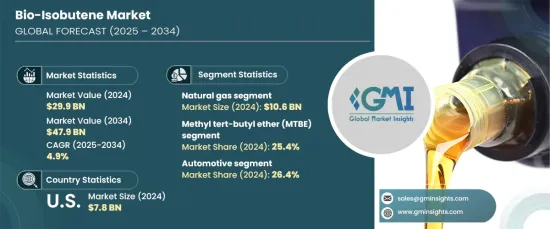
세계의 바이오 이소부텐 시장은 2024년 299억 달러에 달했고, 2025년부터 2034년까지 연평균 복합 성장률(CAGR) 4.9%로 확대될 것으로 예측됩니다.
이 시장 성장의 원동력은 전통적인 석유화학제품을 대체하는 친환경적인 재생가능한 제품에 대한 수요가 증가하고 있는 것입니다. 이산화탄소 배출량을 줄이기 위한 엄격한 규제와 함께 환경에 대한 우려가 계속 증가하고 있는 가운데, 바이오의 화학제품으로의 전환이 기세를 늘리고 있습니다. 더 많은 산업이 지속가능성을 선호하고 있으며, 바이오 이소부텐은 이 변화의 최전선에 있습니다. 유해한 화석연료를 대체할 가능성을 지닌 바이오 이소부텐의 채용은 자동차, 연료첨가제, 소비재 등 다양한 분야에서 가속화되고 있습니다.

시장 개발에는 몇 가지 요인이 기여하고 있으며, 특히 각국 정부가 그린 에너지 솔루션을 추진하고 있습니다. 산업 응용 분야에서 바이오 이소부텐 수요 증가는 이러한 규제 압력의 직접적인 결과입니다. 전 세계의 지속가능성에 대한 노력이 소비자의 선호도와 일치하고, 산업계가 재생 가능한 솔루션을 선택하도록 지원하고 있습니다. 게다가 발효와 새로운 원료 소스의 개발을 포함한 생산 기술의 진보로 바이오 이소부텐을 보다 입수하기 쉬워 비용 효율성도 향상하고 있습니다. 이러한 변화는 보다 깨끗한 에너지 솔루션을 지원할 뿐만 아니라 기업이 환경 규제를 준수하는 데에도 도움이 됩니다. 특히 미국의 산업계가 보다 친환경적인 대체품을 우선시하는 가운데, 바이오 이소부텐은 연료 첨가제나 특수 화학제품 등의 주요 제품에 채용되고 있습니다.
| 시장 범위 | |
|---|---|
| 시작 연도 | 2024년 |
| 예측 연도 | 2025-2034년 |
| 시작 금액 | 299억 달러 |
| 예측 금액 | 479억 달러 |
| CAGR | 4.9% |
바이오 이소부텐 시장은 천연가스, 프로파일렌, 사탕무, 짚 유래 원료, 바이오매스, 농업 폐기물, 목재 등의 원료에 따라 구분됩니다. 천연가스는 시장을 선도해 2024년에는 106억 달러의 수익을 창출했습니다. 이 급성장은 효율적인 메탄 처리를 가능하게 하는 인프라가 이미 확립되어 있어 제품별로 바이오 이소부텐을 생산할 수 있기 때문입니다. 프로파일렌과 바이오매스 원료도 시장 확대에 크게 기여하고 있으며, 각각 다른 제조 공정과 용도를 제공합니다. 바이오 이소부텐 제품 중 메틸 tert-부틸 에테르(MTBE)가 2024년 25.4%로 최대 시장 점유율을 차지하고 있습니다. MTBE의 중요성은 연료에서 산소산염 역할을 하며 옥탄가를 높이고 유해한 배출가스를 줄입니다. 환경의 지속가능성에 대한 주목이 높아짐에 따라 MTBE 수요는 증가의 일환으로 바이오 이소부텐 시장에서 가장 급성장하는 제품 중 하나가 되고 있습니다.
미국에서 바이오 이소부텐 시장은 2024년 78억 달러로 평가됐습니다. 이 성장은 규제 압력과 자동차 및 연료 첨가제와 같은 산업에서 지속 가능한 대체품에 대한 수요가 증가함에 따라 추진되고 있습니다. 미국 시장의 확대는 발효 공정 및 재생가능한 원료의 이용과 같은 바이오 이소부텐 생산 기술의 진보에 의해서도 지원되고 있습니다. 연료 배출 규제를 강화하고 보다 친환경 제품을 추구하는 움직임은 바이오 이소부텐의 광범위한 채용을 촉진하고, 이 지역에서 기존의 석유화학제품을 대체할 수 있는 대체 가능한 대안으로 자리를 잡고 있습니다.
The Global Bio-Isobutene Market reached USD 29.9 billion in 2024 and is projected to expand at a CAGR of 4.9% between 2025 and 2034. The driving forces behind this market growth include the increasing demand for eco-friendly and renewable alternatives to traditional petrochemical products. As environmental concerns continue to mount, coupled with strict regulations aimed at reducing carbon emissions, the shift toward bio-based chemicals is gaining momentum. More industries are prioritizing sustainability, and bio-isobutene is at the forefront of this transformation. With its potential to replace harmful fossil fuels, bio-isobutene's adoption is accelerating across various sectors, including automotive, fuel additives, and consumer goods.

Several factors are contributing to the market's development, especially as governments push for green energy solutions. The increased demand for bio-isobutene in industrial applications is a direct result of these regulatory pressures. Sustainability initiatives across the globe are aligning with consumer preferences, which are pushing industries to opt for renewable solutions. Additionally, advancements in production technologies, including fermentation and the development of new feedstock sources, are making bio-isobutene more accessible and cost-effective. This shift not only supports cleaner energy solutions but also helps companies comply with environmental regulations. As industries, particularly in the U.S., continue to prioritize greener alternatives, bio-isobutene has found its niche in key products such as fuel additives and specialty chemicals.
| Market Scope | |
|---|---|
| Start Year | 2024 |
| Forecast Year | 2025-2034 |
| Start Value | $29.9 Billion |
| Forecast Value | $47.9 Billion |
| CAGR | 4.9% |
The bio-isobutene market is segmented based on raw materials, which include natural gas, propylene, sugar beet, straw-derived feedstocks, and other sources like biomass, agricultural waste, and wood. Natural gas leads the market, contributing USD 10.6 billion in revenue in 2024, with its rapid growth attributed to an already established infrastructure that allows for efficient methane processing, producing bio-isobutene as a byproduct. Propylene and biomass-based feedstocks are also significant contributors to market expansion, each offering distinct production processes and applications. Among bio-isobutene products, methyl tert-butyl ether (MTBE) holds the largest market share at 25.4% in 2024. MTBE's importance lies in its role as an oxygenate in fuels, which boosts octane levels and reduces harmful emissions. As the focus on environmental sustainability intensifies, the demand for MTBE continues to rise, making it one of the fastest-growing products in the bio-isobutene market.
In the U.S., the bio-isobutene market is valued at USD 7.8 billion in 2024. This growth is propelled by a combination of regulatory pressures and the rising demand for sustainable alternatives across industries such as automotive and fuel additives. The U.S. market's expansion is also supported by advancements in bio-isobutene production technologies, including fermentation processes and the utilization of renewable feedstocks. Stricter fuel emission standards and the push for greener products are encouraging the widespread adoption of bio-isobutene, establishing it as a viable substitute for traditional petrochemical products in the region.